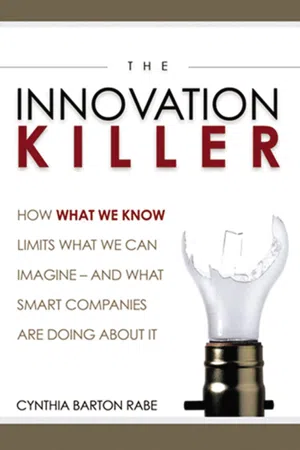![]()
PART I
WHAT’S WEIGHING US DOWN
The intuitive mind is a sacred gift and the rational mind is a faithful servant. We have created a society that honors the servant and has forgotten the gift. —Albert Einstein
Let’s start this book by examining how and why we do this. Chapter 1 outlines the challenges human nature introduces into the innovation process, and discusses the origins of the Zero-Gravity-Thinker concept. Chapter 2 provides an in-depth look at Groupthink, one of our best understood, but most commonly practiced innovation-constraining behaviors. And Chapter 3 details ExpertThink, the tendency we have individually and organizationally to stick with “what we know”—an anti-innovation recipe if ever there was one. This portion of the book outlines the problem. The rest of the book focuses on solving it.
![]()
CHAPTER 1
OUR OWN WORST ENEMY
HOW THE BURDEN OF WHAT WE KNOW LIMITS WHAT WE CAN IMAGINE
A number of studies show that people are less likely to make optimal decisions after prolonged periods of success. NASA, Enron, Lucent, WorldCom—all had reached the mountaintop before they ran into trouble. Someone should have told them that most mountaineering accidents happen on the way down. —Ram Charan, Jerry Useem, Fortune Magazine, May 27, 2002
ANTICIPATION IS ALMOST PALPABLE in New York’s Lincoln Center today. To those just entering, the radiant energy inside the center’s Rose Hall offers a sharp contrast to the clouds and monsoon-like rain of last night. Throngs of people bustle about with purpose, many undoubtedly readying themselves for a day they expect to invigorate and even change them. What I have stepped into is Fortune Magazine’s 2005 Innovation Conference. And, perhaps, what is palpable is not anticipation, but hope.
Innovation is a hot topic. With good reason. Increasingly, what companies in the United States and other economically mature countries are finding is that their counterparts in economically emerging countries (China, India, Russia, etc.) are quickly gaining the ability to offer comparable products and services better, faster, and cheaper than they can. BusinessWeek proposed in a recent article that the age of the “Knowledge Economy” is quickly giving way to what they call the “Creative Economy.”1 It will not, the article suggests, be knowledge that differentiates companies in the future—that playing field is leveling—but the ability to offer new, creative, and innovative products and services. Regardless of whether this global economic sea-change is a conscious consideration—or even the primary one—executives have dived into the innovation current headfirst. In a recent poll by McKinsey Quarterly, top U.S. executives cited the most important factor for growth in their organizations as the ability to innovate.2
It’s no wonder then that conferences like the one at Lincoln Center are packed. It’s also not surprising that almost daily a new article or book is introduced on the subject. We all feel the pressing need to unlock the secrets that will allow us to innovate because so few of us seem to know how. Or, maybe it’s more accurate to say that few of us know how to sustain it in our organizations once we’ve had an initial taste of it.
Why is it so hard? Why, when we attend these conferences and read every one of the latest books and articles—and then faithfully execute their theories—do we so often fall short? My very un-politically correct opinion is that we are handicapped. We are innately disadvantaged when it comes to fostering ongoing innovative thinking in our organizations. And, as it turns out, human nature itself is at the root of the problem.
• FIRST THINGS FIRST: WHAT EXACTLY IS INNOVATION? •
But first things first. Before we talk about innovative thinking, let’s define innovation. Though it seems pretty straightforward, I’ve run across dozens of definitions and never seem to get quite the same answer from different people I talk to on the subject.
“So, you’re writing about ways to come up with new technology products, huh?” a friend of mine at Intel asked when I told him I was writing a book about innovation.
“No,” was my response. “At least I’m not writing only about ways to come up with new technology products.”
The truth is, my friend’s technology/product-oriented definition of innovation is all too common but way too narrow. In business innovations occur all of the time in every function from manufacturing and marketing to customer service and finance. In fact, to get a feel for the link between innovation and various business functions, I decided to conduct a little unscientific test. My theory is that the more the word “innovation” gets paired with a functional word like “engineering” or “finance” in publications, the more likely it is that people in that field are interested in innovating.
With that in mind, I entered the words innovation and engineering in Google and found a whopping 7.1 million references. Innovation and manufacturing brought up over 5 million. And even a search of innovation and accounting (not a function I typically think of as terribly innovative) brought up an impressive 2.5 million references. My point is that innovation is not limited to products and technologies.
The introduction of the Energizer Bunny advertising campaign in 1989, in which the bunny “interrupted” fake television advertisements for such mundane products as pain relievers or allergy medicine, was a highly successful marketing innovation by advertising agency Chiat/Day (Figure 1-1).
Amazon’s use of the Internet (initially for retailing books and then for peddling a host of other products) has been a phenomenal retailing, or e-tailing, innovation. And Intel’s continuous breakthroughs in manufacturing have been innovations as instrumental in its success as its electrical engineering developments.
Outside of business, innovations abound in medicine, government, cooking, and art—the list is endless. Even innovation and legal practice referenced 2.1 million pages on Google! Plain and simple, we humans try to do everything better.
With this in mind, I define innovation as follows:
Innovation is
the application of an idea
that results in a valuable improvement.
Figure 1-1. The Energizer Bunny. ©Eveready Battery Company, Inc. 2004. Reprinted with permission.
A few respected colleagues have argued with me over this definition, saying that it is too broad. The word innovation, they assert, should be reserved for dramatic, disruptive, revolutionary improvements, not for evolutionary upgrades or simple modifications. I understand their point of view, but will respectfully disagree. Sometimes seemingly modest changes can have a significant impact. And whether a change is modest or dramatic is somewhat subjective.
Was it a modest or dramatic improvement when Starbucks (Figure 1-2), which as of this writing has a market capitalization in excess of $4 billion, started selling dark-roasted coffee served by baristas (just as Italians have been doing for years) instead of light-roasted coffee served by waiters (as Americans had been accustomed to)? Was it an evolution or a revolution when in 1913 the Ford Motor Company applied the concept of the conveyer belt, which canneries had been using since the late 1800s, to the manufacture of automobiles in what came to be called the assembly line? Was it a dramatic or simple change in 1982 when the Coca-Cola Company introduced a sugar-free cola to compete with Tab and called it Diet Coke? To the consumers worldwide who have made Diet Coke the 4th most popular carbonated soft drink in the world,3 I don’t think it matters.
Figure 1-2.
The point is that an idea might be fresh and “innovative” to some people, but old hat to others. It might be a seemingly minor tweak to those “in the know,” but one that makes all the difference to a customer. Few innovations simply materialize as if from nothing. And I would argue that those that do aren’t necessarily any better than the ones that simply evolved. The opportunity is to establish a climate where any type of idea that might have value can flourish.
So, I’ll go back to the definition I will use for the purposes of this book: Innovation is the application of an idea that results in a valuable improvement.
• THE ATTACK ON INNOVATIVE THINKING •
The point of the definition is to emphasize that the ability to think innovatively should be a goal for every function in an organization—not just the new product or technology development team. Consider this: Would you rather own stock in a company where all employees from new product development to finance and IT were encouraged to think of new and better ways to do things? Or would you prefer the company that only asked the new product developers to think out-of-the-box? This book is based on the premise that we’d all prefer the former.
Unfortunately, this book is also based on the premise that our ability to think innovatively within each and every function in an organization is under attack. And, the attack isn’t coming from the outside. It’s coming from within. Perhaps most startling is that the threat increases as our companies become more successful.
The villain? Human nature in the form of a couple of tendencies we just can’t seem to get away from. First,
is the tendency we have to try to make decisions that everyone in our close working group will agree with.4 And second, the biggest culprit—think of it as Groupthink-on-Steroids—
is the tendency we have to make decisions with which the “establishment” (the “experts” in our organizations or fields) will agree.
Together these behaviors weigh us down in “what everyone knows”: crushing new ideas, stifling breakthroughs, and, yes, killing innovation before it even surfaces. And unfortunately, there is a wealth of evidence to suggest that both of these behaviors are nearly inevitable in organizations. Groupthink has been written about extensively, and chances are that if you’ve had a course in human resources, psychology, or organizational development you’ve run across the term before. The real question may be why, when we are so smart about it, we continue to engage in it. ExpertThink is a term I came up with after studying the impact of expertise on decision making and finding that Groupthink didn’t quite address everything that was happening. The terms are tightly linked but different, and both are discussed at length in Chapters 2 and 3. The key point here though is that as hard as we might try to guard against them, they insidiously insert themselves into our organizations and wreak havoc—or at the very least thwart optimal performance.
• INNOVATION PHASES AND FILTERS •
Consider the way ideas become reality in most organizations. First there is typically a challenge or opportunity to be addressed. Then someone comes up with an idea for addressing it. A stage of development or fine-tuning typically follows (this can be very short or, in the case of some product or technology innovations, very long) in order to apply the idea. The final result? An innovation (Figure 1-3). An improvement versus the way things were before.
But getting from one side of this funnel to the other is obviously easier said than done. And one of the key places in which we get held up is the area between creative idea and ap...




